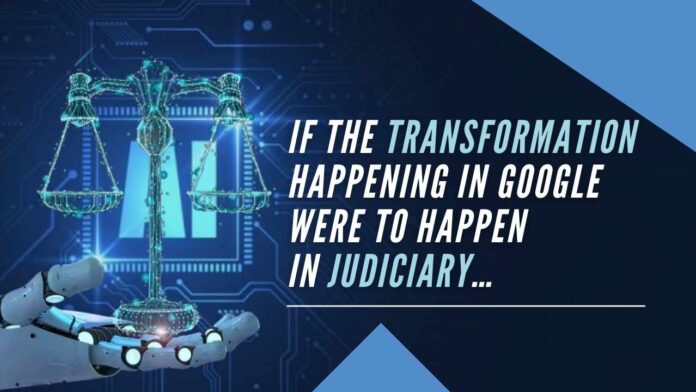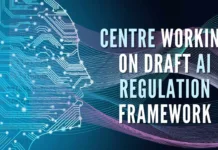
Bringing artificial intelligence into the judicial process
If Rip Van Winkle were to have slept in 1947 and woken up today, he would see himself so much out of place that he would run away to the Himalayas.
But if Rip Van Winkle were a lawyer, and had slept in 1947 and waking up today, he would be very comfortable arguing cases in our courts even today, except for his ignorance of the amendments in some laws. As far as the justice delivery process goes, it is almost the same today, except that typewriters have been replaced by computers (though computers continue to be used much the same way typewriters were used those days).
If only the kind of transformation happening in modern companies like Google (Alphabet Inc) were to happen in the judiciary at SC, HC, and the lower court levels…
An immediate jump of justice delivery quantitatively, many times over, at least 10s of times, if not 100, would have become a reality.
In one big leap, all sub-domains of technologies would have been implemented. We would have virtual courts & hearings, automated notices, follow-ups, and submissions by the parties, artificial intelligence-based ‘de facto’ judgments at the prima facie stage to aid the judges in quick decision making, intelligent data storage and retrieval of similar cases all over India by the judges, big data analytics of past case histories and judgments to get a sense of how the judiciary in heading on different issues, and lots more.
There would be almost no vacancy in the judiciary, some disagreements between the government and the judiciary notwithstanding.
Backlog in court cases would have been wiped out or just made very few if at all, of just the cases of the last few months.
Cost per judgment would be a fraction of the current costs, much of the indirect costs due to multiple adjournments having disappeared. It will immensely benefit the people.
There would be much less corruption in politics since the judiciary would have put many of the corrupt in jail. (Sure enough, police also have an important role to play in this, but the judiciary would have put the fear of job and liberty in the minds of the police, politicians, and bureaucrats).
The quality of judgments would be far better, aided by artificial intelligence.
There would be much more peace and harmony in society, enforced by the active intervention of the judiciary.
Since legal systems would have become substantially more reliable and speedy, doing business will become easier and hassle-free, and people’s living easier too.
Is it all a pipe dream? It is if the people who should make it happen think so. It can become a reality if the people who should make it happen think so, and work to make it happen.
Some projects were initiated with the constitution of committees within the Supreme Court (SC) to introduce technology into the judicial system, but the common man has no idea if they are making any kind of headway.
It is doubtful if anyone has a real understanding of the possibilities that come up with the introduction of technology like in the high-tech industry, and if anyone is really interested in judicial reforms to solve all the problems associated with the judiciary.
Even if the number of judges per million of the population was increased to the world’s best levels, the shortfall in judgments compared to new cases is so much that we will be nowhere close to delivering enough judgments, not to talk of quality and timeliness of judgments. The huge backlogs make the situation far worse. Even all the tall talk of alternative systems like mediation and adjudication has not happened on the ground.
Let’s be honest; even if all the wishes of the judiciary were to come true, we’ll not be significantly better than where we are. When we can’t reach our destination by running faster, we should consider smarter options.
IT and just about every industry has had to keep reinventing themselves every year to survive. But not so with the judiciary. (So is the case with government and bureaucracy too, and they will be subjects of discussion on another day.) Because the judiciary is a monopoly, with no competition, or any serious accountability to anyone.
It’s high time our judiciary and the government start thinking big, as outlined in this article.
Note:
1. Text in Blue points to additional data on the topic.
2. The views expressed here are those of the author and do not necessarily represent or reflect the views of PGurus.
PGurus is now on Telegram. Click here to join our channel and stay updated with all the latest news and views
For all the latest updates, download PGurus App.
- How BJP can get 33%+ vote share in TN - April 1, 2024
- A transparent, equitable electoral funding alternative - March 19, 2024
- How TN BJP can come to No. 1 or No. 2 in 2024 LS polls - January 11, 2024











[…] No a lot authorities, a lot much less judiciary (which I wrote about in an article titled, “If the transformation that’s occurring at Google occurred within the judiciary” […]
[…] but not so much governance, much less judiciary (which I wrote about in an article titled, “If The Transformation Happening In Google Were To Happen In Judiciary” [1]).The biggest change technology can bring about in governance, of the country, states, and […]
[…] but not so much governance, much less Judiciary (which I wrote about in an article titled, “If The Transformation Happening In Google Were To Happen In Judiciary” […]
The current law minister seems receptive to ideas and want to implement changes to the judicial system. Why cant’s some AI/computer domain experts join together draw a workable and implementable plan (for INdia) and submit to the justice minister for review. The devil in the details.